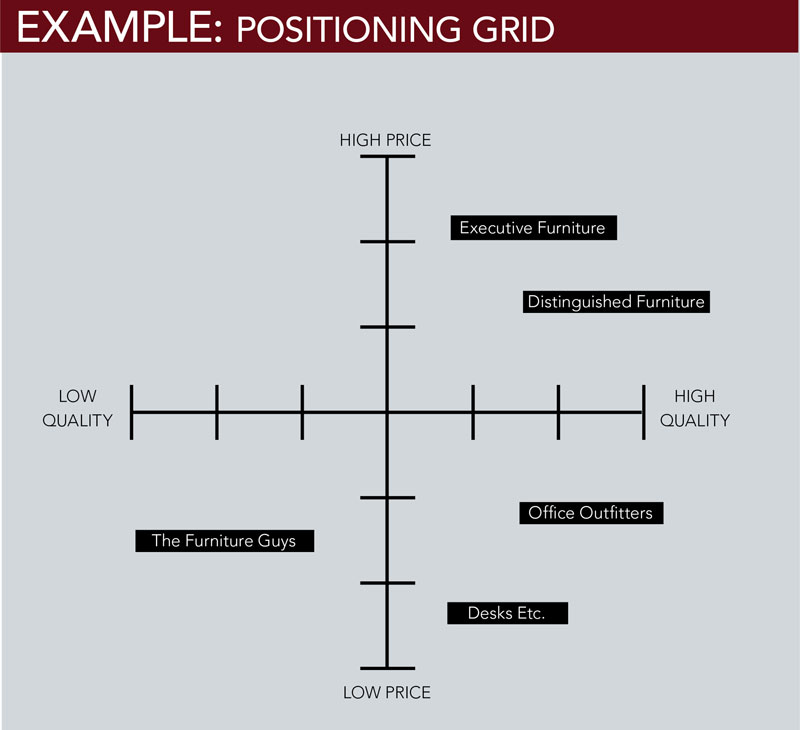Market Position
Your Market Position is the location your business occupies in the minds of your customers. It does not necessarily need to meet the specific needs of every possible customer. It must, however, meet the needs and wants of those who fit your Target Market profile. Others will be attracted to it simply because it fits with their own self-image. Mark's Work Wearhouse, for example, has positioned itself as a leader in providing durable, industrial “work-clothes,” yet many of its customers will never set foot in an industrial work site. So why are they attracted to a Market Position that doesn’t appear to address their needs?
Their customers are responding to the desire for hard wearing clothes at reasonable prices; something that's consistent with the perception of industrial work clothes. Additionally, people who buy industrial work clothes for everyday wear may associate themselves with the “rough and tough” image of tradespeople.
What is the value of a clear Market Position?
Security — It gives you a toehold in the marketplace by claiming a piece of it as your own.
Growth — It positions you as a market leader; a powerful place to be in the minds of your prospects.
Communication — It pushes your message through the general marketing clutter to the people you want to reach.
Solidarity — It publicly supports your shared Corporate Vision.
The following exercises will help you identify the Market Position for your business. Make sure you keep your Corporate Mission, Values, Vision and Strategic Objectives in mind as you go through them.
What are the three most common complaints about businesses in your industry by your Target Market? For example, common complaints about service industry companies are wait times, or the quality of customer service. (If you can position your business as the solution to this complaint you'll have a powerful focus indeed.)
Give at least three reasons your business is, or could be, unique.
Positioning Grids
A Positioning Grid offers a visual representation of your competitors' market positions. Used properly, this tool can help you get clear on your own market position. It can also help you uncover additional untapped market positions for your business or your products.
For example, if you own a furniture manufacturing company, two important positioning factors might be “price” and “quality.” The following Positioning Grid illustrates this example for a mid-cost, modern-style office furniture manufacturer called Office Outfitters. It shows Office Outfitters nicely positioned within their market based on these factors. Of course, “price” and “quality” are not the only positioning factors to consider for a furniture store. Others factors might be selection, style, convenience, service, brand awareness and so forth. It's unlikely they would compete directly with an office equipment manufacturer, for example.

Potential Market Positions
Following is a list of potential market positions. Some are current and some are not, but read through the examples and consider their possible relationship to your own marketing position.
Positioning by product and business history e.g. Heinz: “There are no other kinds.” Coke: “It's the real thing.” This approach works best when the product or business was first to the market or has a substantial history.
Positioning by size and popularity e.g. British Airways: “The world's favorite airline.” If you can't be number one in your main category, try a narrower category. For example, a computer store might not be number one in computer sales across the country, but they might be number one in laptop computer sales in the district.
Positioning by convenience e.g. Shoppers Drug Mart: “Everything you want in a drug store.” This could be convenience of product selection or convenience of location.
Positioning by service e.g. People's Jewelers: “Where people come first.” Customers have fairly high expectations regarding service these days, but if you stand out, this is still an excellent position.
Positioning in relation to a competitor e.g. Avis: “We're number two. We try harder.” In the case of Avis, they positioned themselves against the number one competitor, Hertz. The suggestion was, because Avis was number two, they couldn't afford to rest on their laurels and were willing to work harder for the customer. Positioning by product attribute e.g. Subaru: “All Wheel Reflexes. It’s What Makes a Subaru, a Subaru.” This is a good approach if your products or services stand out from your competitors' in some way.
Positioning by price and quality e.g. Ducane Gas Grills: “Buy your last grill first.” Use this approach if you offer exceptionally high quality or low prices.
Positioning by product use e.g. 7-Up: “The Uncola.” This approach is effective for promoting alternative uses for your products and services. 7-Up, for example, was primarily used as a mixer for drinks that were mostly consumed by older people. The “Uncola” campaign was effectively used to promote its use as a soft drink for children, teenagers, and young adults. 7-Up is now regularly consumed as a drink unto itself.
Positioning by solution i.e. Federal Express: “When it absolutely positively has to be there overnight.” This positioning promotes the primary benefit your product has to your customers.
Positioning by Target Market i.e. Business Development Bank of Canada: “In business for small business.” You can use this approach if you are a primary supplier to your Target Market.
Use the Positioning Grid to locate your competitors and yourself in relation to your possible marketing positions. Keep in mind this isn't an exact science. You’ll likely want to play around with various scenarios until something really clicks.
Positioning Statement
This is a brief statement that outlines your unique market position. For example, you might say your business provides or intends to provide the fastest turn-around times of any dry cleaner in your area.
Based on your work so far, briefly outline the most likely Market Position for your business in the space below.